Stone Age Peoples - Photo gallery
Image database with photographs of ancient art and antiquities
Our image database provides photographs of ancient art and antiquities for press releases as well as for private use. All artefacts sold in our gallery are documented through professional photographs. The resulting image library contains numerous ancient Egyptian, Greek and Roman antiquities as well as ancient coins. The time span from Stone Age, over Bronze Age and Classical Antiquity until Late Antiquity is covered.The photo gallery aims at providing a vast visual archive equipped with filters and search tools. You are most welcome to search the constantly growing number of artefacts in the image library. We are also happy to authorize hyperlinks from your webpage / forum to the objects depicted in our gallery. For this purpose, please send us a short notification prior to placing a hyperlink. For almost every object high definition photographs are available and can be provided e.g. to document your collection or for scientific papers or popular science articles. If you are interested in using pictures for publications, print media or other purposes, please contact us and we will be happy to assist you.
-
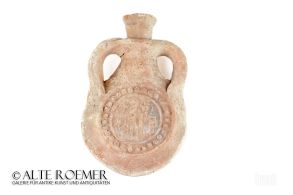 Perfectly preserved ampulla of Saint Menas
Perfectly preserved ampulla of Saint MenasFrühchristliche Pilgerflasche mit Darstellung des Heiligen Menas. Aus der sehr alter US-Amerikanischer Sammlung des Pharmakologen Prof. Dilling, erworben in den frühen 1900er Jahren. Als Kauf- oder Fundort ist Alexandria überliefert.
Price: on request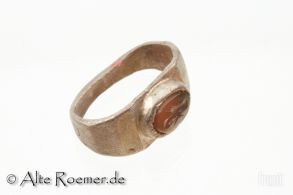 Roman silver wedding ring with intaglio showing dextrarum iunctio
Roman silver wedding ring with intaglio showing dextrarum iunctioSchönes Intaglio aus durchscheinend-rotem Karneol. Es zeigt die dextrarum iunctio, welche symbolisch für Verlobung oder Hochzeit steht. 16mm x 10mm Innenmaße. 3. Jh. n. Chr.
Price: on request Hellenistic-Roman silver ring with intaglio showing a portrait
Hellenistic-Roman silver ring with intaglio showing a portraitDer antike Goldring mit wunderschönem Intaglio entstammte einst einer wohlhabenden Familie. Das Intaglio ist zeigt einen Porträtkopf im linearen Stil und ist in perfektem Zustand.
Price: on request Large decorated dress pin
Large decorated dress pinLange Gewandnadel aus der späten Bronzezeit Mitteleuropas. Der Kopf ist elegant mit Querrippen verziert. Mit edler Fundpatina.
Price: on request Iron Age bronze bracelet
Iron Age bronze braceletSchöner Armreif aus Bronze mit Fischgrätendekor. Interessanter Typ mit Parallelen zu Südeuropa in vorrömischer Zeit. Massives Schmuckobjekt in hervorragender Erhaltung mit edler Patina.
Price: on request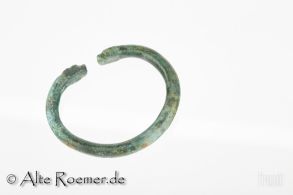 Rare Iron Age bronze bracelet with lion heads
Rare Iron Age bronze bracelet with lion headsSeltener Bronzereif aus der Eisenzeit mit kunstvoll geformten Enden. Das Schmuckobjekt wurde vermutlich als Armreif oder Fußreif getragen. Massive Bronze.
Price: on request Byzantinian bronze bracelet with rich decorations
Byzantinian bronze bracelet with rich decorationsReich verzierter Armreif mit Rillen und Kerbdekor. Offene Kreisform. Ein schönes Exemplar aus hervorragend erhaltener Bronze.
Price: on request Elegant Roman glass bottle - found in a ship wreck in the Mediterranean
Elegant Roman glass bottle - found in a ship wreck in the MediterraneanKleine römische Flasche aus klarem, farblosem Glas. Fund aus einem Schiffswrack im östlichen Mittelmeer. Produktion aus der römischen Kaiserzeit, 1. bis 2. Jh. n. Chr.
Price: on request Small Roman perfume bottle from an old Danish collection
Small Roman perfume bottle from an old Danish collectionBeliebter Gefäßtyp aus der römischen Kaiserzeit, der vermutlich für Parfum oder sonstige Duftstoffe verwendet wurde. Aus dänischer Generationensammlung.
Price: on request Roman perfume bottle with beautiful patina - found in a ship wreck in the Mediterranean
Roman perfume bottle with beautiful patina - found in a ship wreck in the MediterraneanDas Glasfläschchen ist mit einer ausgeprägten und farbenfrohen Patina überzogen. Der Gefäßtyp wurde im gesamten römischen Handelsraum verwendet. Schiffswrackfund.
Price: on request Aubergine-colored Roman glass vessel - found in a ship wreck at the Cretan coast
Aubergine-colored Roman glass vessel - found in a ship wreck at the Cretan coastElegantes Fläschchen aus wunderschönem auberginfarbenen Glas mit anhaftender, dezenter weißer Meerespatina. Das Gefäß stammt aus einem Schiffswrackfund vor der Küste der Insel Kreta.
Price: on request Dark bone die from Roman imperial period
Dark bone die from Roman imperial periodRömische Kaiserzeit, ca. 2.-3. Jh. n. Chr. Seltene dunkle Variante eine römischen Spielwürfels in perfekter Erhaltung. Könnte auch heute noch für Spielzwecke eingesetzt werden.
Price: on request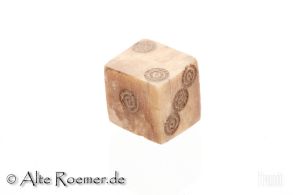 Bone die from Roman imperial period
Bone die from Roman imperial periodRömische Kaiserzeit, ca. 2.-3. Jh. n. Chr. Attraktive Tönung, perfekt erhalten. Könnte auch heute noch für Spielzwecke eingesetzt werden.
Price: on request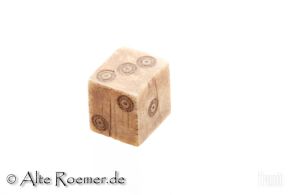 Bone die from Roman imperial period
Bone die from Roman imperial periodRömische Kaiserzeit, ca. 2.-3. Jh. n. Chr. Attraktive Tönung, perfekt erhalten. Könnte auch heute noch für Spielzwecke eingesetzt werden.
Price: on request Roman discus fibula with color glass paste
Roman discus fibula with color glass pasteSpannende Fibel mit Sterndekor und Glaspaste. Eine Weiterentwicklung keltischen Kunsthandwerks in der Zeit römischer Herrschaft. Gut dokumentierter Typ aus dem 2. Jh. v. Chr. mit Verbreitung in weiten Teilen Europas.
Price: on request Gallo-Roman animal fibula
Gallo-Roman animal fibulaZoomorphe Fibel mit Wildtier als Motiv. Schmuckstück mit religiöser Symbolik, vergleichbar einem Kreuzanhänger bei heutigen Christen. Gefertigt im 1. bis 3. Jh. n. Chr. in Gallien.
Price: on request Visigoth bronze fibula
Visigoth bronze fibulaAus der prägenden Zeit der Völkerwanderung. Fund aus England. Import oder lokale Imitation eines Fibeltyps der Westgoten bzw. Visigothen aus dem 5. bis 6. Jh. n. Chr.
Price: on request Early Merovingian silver fibula
Early Merovingian silver fibulaMuseumswürdiges Exemplar aus dem 5. bis 6. Jh. n. Chr. Fränkischer Fibeltyp mit typischer rautenförmiger Fußplatte. Sehr kunstvoll verziert mit Vergoldung, Schmucksteinen und stilisiertem Tierkopf.
Price: on request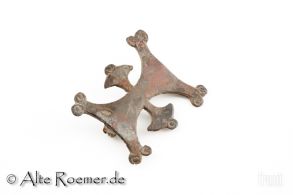 Rare discus-shaped Celtic-Roman fibula
Rare discus-shaped Celtic-Roman fibulaAus der Entstehungszeit der plattenförmigen Fibeln, 1. Jh. n. Chr. Ästhetisch ansprechende Metallarbeit aus einer Fusion keltischer Handwerkstraditionen mit römischen Vorlieben.
Price: on request Enameled Galo-Roman fibula
Enameled Galo-Roman fibulaGrundform einer rechteckigen Platte, erweitert durch Zierknopf an Kopf- und Fußende. Drei Paare von Dreiecken auf der Platte sind durch weiße Einlagen hervorgehoben. Etwa 2. Jh. n. Chr.
Price: on request Impressively preserved enameled Roman brooch
Impressively preserved enameled Roman broochIn Britannien und Gallien produzierter Fibeltyp des zweiten Jahrhunderts. Edel patinierte Bronzeoberfläche. Besonders hervorzuheben ist die Emailauflage in selten gutem Erhaltungszustand.
Price: on request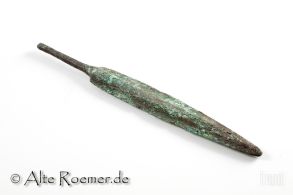 Near Eastern Bronze arrow head - from the famous Guttmann collection, ex Christies
Near Eastern Bronze arrow head - from the famous Guttmann collection, ex Christies2nd to early 1st millenium BC. From the famous Guttmann collection. Ex-Christies. Found in North-Western Persia.
Price: on request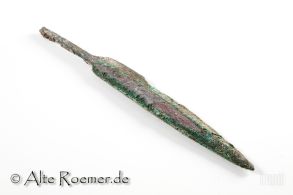 Near Eastern Bronze arrow head - from the famous Guttmann collection, ex Christies
Near Eastern Bronze arrow head - from the famous Guttmann collection, ex ChristiesVerstärkte Mittelrippe, rechteckiger Schaft. 2. Jt. v. Chr. bis frühes 1. Jt. v. Chr. Aus der berühmten Guttmann-Sammlung, ex-Christies. Fund aus dem Nord-Westen Persiens.
Price: on request Near Eastern Bronze arrow head - from the famous Guttmann collection, ex Christies
Near Eastern Bronze arrow head - from the famous Guttmann collection, ex ChristiesVerstärkte Mittelrippe, rechteckiger Schaft. 2. Jt. v. Chr. bis frühes 1. Jt. v. Chr. Aus der berühmten Guttmann-Sammlung, ex-Christies. Fund aus dem Nord-Westen Persiens.
Price: on request Near Eastern Bronze arrow head - from the famous Guttmann collection, ex Christies
Near Eastern Bronze arrow head - from the famous Guttmann collection, ex Christies2nd to early 1st millenium BC. From the famous Guttmann collection. Ex-Christies. Found in North-Western Persia.
Price: on request Ancient bronze bracelet with double-conic end pieces
Ancient bronze bracelet with double-conic end piecesPopular type of bracelet. Massive bronze open ring with circular profile and decorated ends. Roman jewellery of this type is a revival of earlier Greek art.
Price: on request Ancient bronze bracelet with impressive patina
Ancient bronze bracelet with impressive patinaOvaler Armreif mit Überlapp. Die Enden sind in charakteristischer Weise verdickt und bilden einen klaren Abschluss. Attraktive polychrome Patina.
Price: on request Elegant Roman glass bottle with globular body and long neck
Elegant Roman glass bottle with globular body and long neckImpressive patina and colourful iridescence. 1st to 3rd century AD.
Price: on request Conic Roman glass bottle from and old Danish collection - found in Greece
Conic Roman glass bottle from and old Danish collection - found in GreeceInteressante Glasform der römischen Zeit. Aus einer dänischen Generationensammlung, alter Fund aus Griechenland.
Price: on request Small glass bottle for perfume - Roman imperial period
Small glass bottle for perfume - Roman imperial periodGlass flask from Roman Imperial times. Excellent condition. Fully intact, cleaned on the outside, patinated on the inside. From a danish family collection.
Price: on request Beautiful Roman glass bottle
Beautiful Roman glass bottleBeeindruckendes Fläschchen aus der römischen Zeit. Seinerzeit vermutlich für Parfüm oder kostbare Duftöle verwendet. Das Glas schimmert durch starke Irideszenz in allen Farben. Wunderschönes Exemplar!
Price: on request Ancient silver ring with nice design
Ancient silver ring with nice designRing made of silver with lozenge shaped plate. Engraved decorative design on the plate. Inner diameter 16mm to 18mm.
Price: on request Byzantine finger ring showing blossom
Byzantine finger ring showing blossomByzantinischer Fingerring aus Silber mit schönem Blütenmotiv. In hervorragender Erhaltung und theoretisch auch heute noch als Amulett oder Fingerring tragbar. Innendurchmesser 18mm bis 19mm.
Price: on request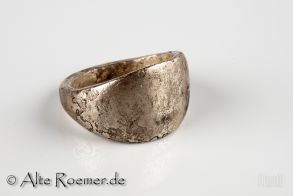 Roman or Byzantine silver ring
Roman or Byzantine silver ringEinfach geformter Fingerring aus Silber, römisch bis frühbyzantinisch. Innendurchmesser 14,5mm.
Price: on request Amphipolis tetradrachm showing bust of Artemis Tauropolos
Amphipolis tetradrachm showing bust of Artemis TauropolosMakedonischer Schild, darauf zentral Büste der Artemis Tauropolos, über der Schulter Bogen und Köcher. Fast vorzüglich erhaltenes Exemplar.
Price: on request Group of 3 Scythian-Greek arrow heads
Group of 3 Scythian-Greek arrow headsCharacteristically shaped ancient bronze arrow heads. With three wings and barbed hooks. Perfect condition with lovely patina. Typical for the Scythians from 700 BC to hellenistic times.
Price: on request

